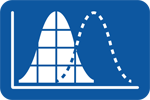Correlation: Conceptual Overview Video
The Pearson-Product Moment Correlation Coefficient (r) (often simply referred to as the correlation) is the most common index of a linear association between two measurement variables. The word correlation comes from two words in Latin, cor (or com) meaning “together” and relatio which means relation. Like other measures of association r can take any value between 0 and 1.0 and r can be either negative or positive. One way to begin to understand r is to define it as the covariance of the two variables divided by the product of the standard deviations of the two variables. Covariance indicates how changes in the values of one variable are predictable from changes in another variable.
From the formula for r, it can be seen that as the covariance of the two variables approaches the product of their standard deviations, r approaches 1.0. As the covariance of the two variables approaches 0.0, r approaches 0.0. Stated another way, r is the ratio between (1) the amount of observed covariation between two variables and (2) the amount of covariation that would be observed if the two variables were perfectly associated with one another. Perfectly associated means that if you knew the value of one variable, you would be able to predict the value of the other variable without any error. When two variables are perfectly associated the product of the standard deviations is the maximum possible covariance that can be observed between those two variables.
- Understand the key concept of covariance
- Appreciate how a correlation coefficient is a standardized index of the strength of the linear association between to variable
- Recognize the difference between positive and negative correlations
- Using data points and scatterplots, demonstrate the factors that influence the strength of a correlation





